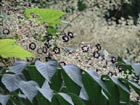The Importance of Stewardship
Stewardship has become necessary to protect our natural heritage – If we do not actively counter human impacts, then the diverse native ecosystems that have developed over thousands of years will degrade into a motley assemblage of weedy plants and animals.
'Nature manages itself' is a common phrase uttered by those that feel stewardship of natural resources is inappropriate. In some cases, this is based upon a simplistic understanding of natural systems and the forces that create and maintain them. Some proponents of this view fail to acknowledge that our current use of the landscape results in de facto negative stewardship -- human activities with severe and perpetual negative impacts including introductions of invasive species, maintenance of overabundant deer herds, suppression of wildfires, irreversible fragmentation of natural areas and changes to the climate. Other proponents of this view suggest that nature will have to balance itself within the framework established by human activities and that we should not intervene further. Regardless of the rationale, a lack of stewardship to counter human impacts results in weakened natural systems largely devoid of our native biota that quietly sustain both humans and all other living things.
In contrast, proponents of stewardship proceed from the viewpoint that human activities shape the remainder of our natural world and that there is an obligation to intervene to protect and restore biodiversity. Although humans are part of the natural world, our impacts are much more intense than any other species on the planet. In this context, stewardship may be defined as 'the mitigation of disproportionate human impacts on natural systems'.
Can stewardship really work?
New Jersey has a long history of fostering the recovery of particular species such as the bald eagle, osprey and peregrine falcon. Populations of these birds had been severely reduced by the use of pesticides that weakened their egg shells. All of these species are now more common than they were 30 years ago due to the diligence of conservationists.
Today, our forest ecosystems are gravely threatened by deer overabundance and invasive species. Many common native plants and animals have become uncommon and some rare species have begun to disappear under the onslaught of browsing deer and invasive species infestations. But, again, stewardship efforts are beginning to provide small but brilliant signs of hope. At places such as the Ted Stiles Preserve at Baldpate Mountain, implementation of a Deer Management Program is beginning to allow native plants to compete with invasive plants. At Duke Farms, a forest is recovering from severe deer overabundance - native trees, shrubs and herbs are thriving inside a deer exclosure and an effective hunting program promises similar results throughout the property. In addition, Duke Farms has begun to replace old plantings of invasive species with native species that will enhance, rather than threaten surrounding natural systems.
The Road Ahead
There are many individual success stories involving numerous groups throughout New Jersey, but the future health of our ecosystems can only be assured through the continued diligence of the conservation community backed by broad support from private citizens and public officials. In short, improved outreach is required to spur deeper concern and investment toward protecting our natural heritage. If we fail in this endeavor, future generations will not be able to witness the full splendor of nature that can exist even in a densely populated state like New Jersey.

The photo on the left represents 'The Good' (a.k.a. The ultimate goal): Forests filled with native trees, shrubs and herbs. 'The Bad' (center): Forest understory completely empty of native plants less than 4 feet tall because of excessive deer browse. 'The Ugly' (right): Forest being collapsed by vines and unable to produce new trees because of excessive deer browse - the canopy gap is filled by unpalatable invasive species.

